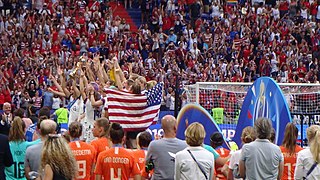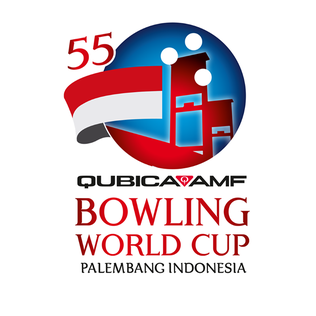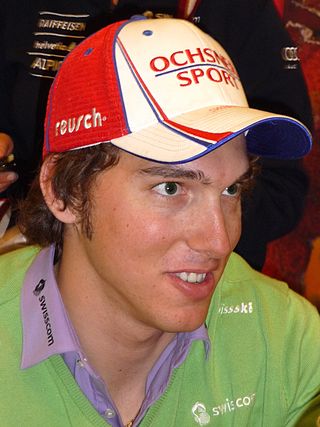
The decathlon is a combined event in athletics consisting of ten track and field events. The word "decathlon" was formed, in analogy to the word "pentathlon", from Greek δέκα and ἄθλος. Events are held over two consecutive days and the winners are determined by the combined performance in all. Performance is judged on a points system in each event, not by the position achieved. The decathlon is contested mainly by male athletes, while female athletes typically compete in the heptathlon.

The FIS Alpine Ski World Cup is the top international circuit of alpine skiing competitions, launched in 1966 by a group of ski racing friends and experts which included French journalist Serge Lang and the alpine ski team directors from France and the USA. It was soon backed by International Ski Federation president Marc Hodler during the FIS Alpine World Ski Championships 1966 at Portillo, Chile, and became an official FIS event in the spring of 1967 after the FIS Congress at Beirut, Lebanon.

Downhill is a form of alpine skiing competition. Whereas the other alpine skiing events emphasize turning and technique, downhill emphasizes "the six components of technique, courage, speed, risk, physical condition and judgement", according to the FIS "International Ski Competition Rules (ICR)". Speeds of up to 130 km/h (81 mph) are common in international competition. Athletes must have an aerodynamically efficient tuck position to minimize drag and increase speed.

The FIFA Women's World Cup is an international association football competition contested by the senior women's national teams of the members of Fédération Internationale de Football Association (FIFA), the sport's international governing body. The competition has been held every four years and one year after the men's FIFA World Cup since 1991, when the inaugural tournament, then called the FIFA Women's World Championship, was held in China. Under the tournament's current format, national teams vie for 31 slots in a three-year qualification phase. The host nation's team is automatically entered as the 32nd slot. The tournament, called the World Cup Finals, is contested at venues within the host nation(s) over a period of about one month.

The FIS Nordic World Ski Championships is a biennial Nordic skiing event organized by the International Ski Federation (FIS). The World Championships was started in 1925 for men and opened for women's participation in 1954. World Championship events include Nordic skiing's three disciplines: cross-country skiing, ski jumping, and Nordic combined. From 1924 to 1939, the World Championships were held every year, including the Winter Olympics. After World War II, the World Championships were held every four years from 1950 to 1982. Since 1985, the World Championships have been held in odd-numbered years.

Marc Girardelli is an Austrian–Luxembourger former alpine ski racer, a five-time World Cup overall champion who excelled in all five alpine disciplines.
The 26th World Cup season began in November 1991 in the United States and concluded in March 1992 in Switzerland. The overall winners were Paul Accola of Switzerland, his first, and Petra Kronberger of Austria, her third straight.
The 25th World Cup season began in August 1990 in New Zealand, resumed in December, and concluded in March 1991 in the United States. The overall winners were Marc Girardelli of Luxembourg, his fourth title and Petra Kronberger of Austria. This was the first season following the reunification of Germany and the last before the dissolution of Yugoslavia.
The 20th World Cup season began in August 1985 in Argentina, resumed in December 1985 in Italy, and concluded in March 1986 in Canada. Because of the South America events, this was the first time that the World Cup season had started prior to December 1. The overall champions were Marc Girardelli of Luxembourg, his second consecutive overall win, and Maria Walliser of Switzerland, her first.
The 14th World Cup season began in December 1979 in France and concluded in March 1980 in Austria.

The QubicaAMF Bowling World Cup, previously known as the International Masters and AMF Bowling World Cup, is an annual Ten-pin bowling championship sponsored by QubicaAMF Worldwide, and the largest in bowling in terms of number of participating nations. Each nation chooses one male and/or one female bowler to represent them in the tournament, and in the majority of cases, this is done by running a qualifying tournament, the winners of which are chosen.
Gustav Weder is a Swiss bobsledder who competed from the late 1980s to the early 1990s. Competing in three Winter Olympics, he won four medals with two gold, one silver, and one bronze.

Wolfgang Hoppe is a former East German decathlete, bob pilot and 36-time international medal winner who competed from the early 1980s to the late 1990s. Competing in four Winter Olympics, he won six medals with two golds, three silvers, and one bronze (1994).
The Bobsleigh World Cup is an annual bobsleigh competitions. It has taken place since the 1984 Winter Olympics. Below is a lists of season champions. Each table shows the country and driver only.
William Besse is a Swiss former alpine skier. He took four wins and 13 podiums in the FIS Alpine Ski World Cup, all of them in the downhill discipline, including winning the Lauberhorn downhill in Wengen in 1994. He retired from competition in 1999, in part because he struggled to adapt to the introduction of carving skis in the mid-1990s. After retiring from competition, he became a ski instructor in Verbier, and also worked as an analyst for Télévision Suisse Romande and Radio Télévision Suisse's coverage of alpine skiing, until he was let go after the 2014-15 season.

The 44th World Cup season began on 24 October 2009, in Sölden, Austria, and concluded on 14 March 2010, at the World Cup finals in Garmisch, Germany.
The 1991 IAAF World Race Walking Cup was held on 1 and 2 June 1991 in the streets of San Jose, California, USA. The event was also known as IAAF Race Walking World Cup. The course followed a loop along Park Avenue and Almaden Boulevard, north and east of the intersection.
The European Combined Events Team Championships is a track and field competition for European combined track and field events specialists, with contests in men's decathlon event and women's heptathlon. It is organised by European Athletics. It was held annually in 1993–2011 and biennially in 1973–1993 and 2011–2019.

The IFSC Climbing World Cup is a series of competition climbing events held during the year at various locations around the world, organized by the International Federation of Sport Climbing (IFSC). At each event, the athletes compete in three disciplines: lead, bouldering, and speed. The number of events varies from year to year, and the winners for each discipline are decided by the points accumulated in the year.

La face de Bellevarde is a World Cup downhill ski course in France, on Rocher de Bellevarde mountain in Val d'Isere, Savoie; it debuted at the 1992 Winter Olympics with the men's downhill.










